
- Colston Loveland can be an immediate top-12 fantasy tight end: While Loveland’s volume stats aren’t elite, his per-play metrics match up to other great young tight ends of recent seasons.
- The Chicago Bears were the perfect landing spot: New head coach Ben Johnson helped Sam LaPorta become an elite fantasy option with the Detroit Lions, and he can do the same with Loveland in Chicago.
- Final chance to claim 25% off PFF+: Use code DRAFT25 and unlock access to player grades, fantasy tools and the 2025 Draft Guide
Estimated Reading Time: 5 minutes

PFF’s Fantasy Football Player Profile series delivers the most in-depth fantasy football analysis available for the 2025 season.
Using PFF’s exclusive data, we evaluate player performance, competition for touches and how teammates and coaching staffs will impact each player’s fantasy football outlook.
Last updated: 7:15 a.m. Tuesday, April 29
Click here for more draft tools:
NFL Draft Big Board | Mock Draft Simulator | NCAA Premium Stats
2025 PFF Draft Guide | Mock Draft Hub | Prospect Data Profiles
Draft Position Rankings
Player performance
Loveland became the Wolverines’ second tight end behind Luke Schoonmaker in 2022, running nearly as many routes as the current Dallas Cowboy. In 2023, current Seattle Seahawk AJ Barner transferred to Michigan. Barner was the better blocker, but Loveland emerged as the better receiver. Loveland missed some time early and late in the 2024 season but remained Michigan’s top receiving option at the position with even better per-game and per-play numbers.
Michigan‘s run-heavy offense limited Loveland’s routes. The Wolverines often had a significant lead by the fourth quarter, which limited Loveland’s playing time in those games. From a situational perspective, he was nearly perfect in every way except crossing routes. He also didn’t perform well in contested catch situations.
Loveland’s 88.5 receiving grade over the last five seasons ranks eighth-best among Power-Five tight ends, behind Brock Bowers, Dalton Kincaid, Charlie Kolar, Michael Mayer, Tyler Warren, Maliq Carr and Sam LaPorta. At least part of the reason he’s lower is volume, as his 2.22 yards per route run is fourth-best and better than fellow potential first-round tight end Warren. Loveland’s separation rate was in the 96th percentile among tight ends over the last two seasons. He has the talent to be a top-12 fantasy tight end as a rookie.
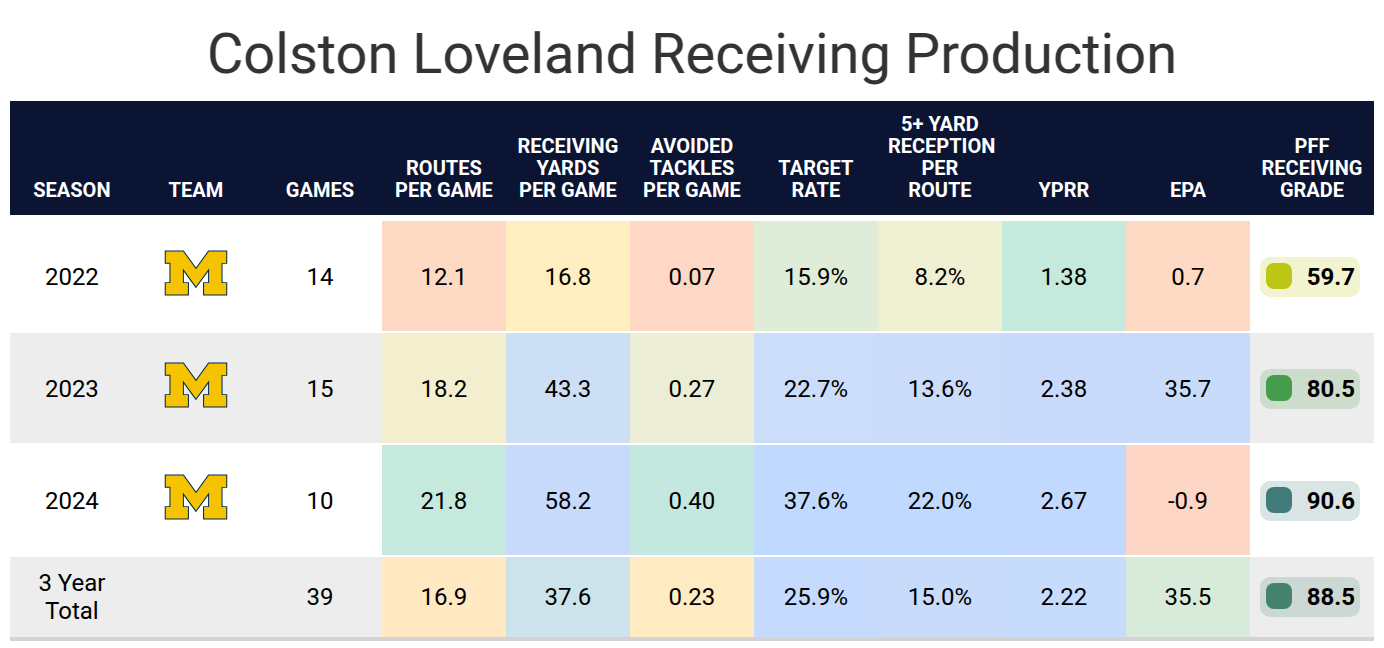
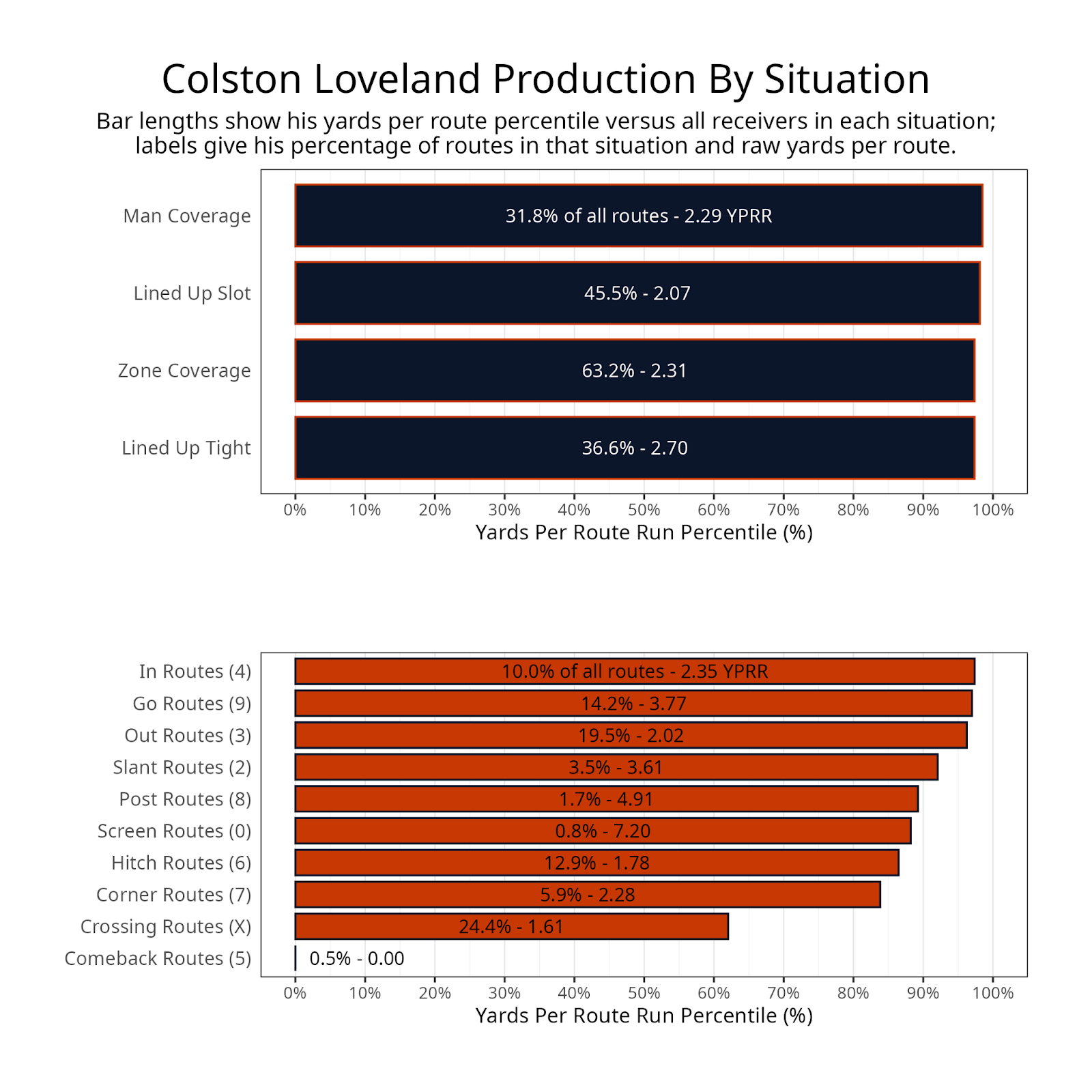
Projected role
Loveland is expected to be the featured tight end in the Chicago Bears‘ offense. Chicago has long-time starter Cole Kmet, but Kmet was part of a previous regime and had a down season last year. The Bears’ regime last season also didn’t think Kmet should be a Week 1 starter. A team doesn’t pick a player with a top-10 pick without expecting them to be in a feature role. We can still expect to see plenty of Kmet in two tight end sets, but that won’t be enough to make Kmet fantasy-relevant.
There is at least a chance Loveland could lose some snaps on early downs. Our draft guide’s top weakness for Loveland is that he “shows fundamentals in blocking but lacks the true size to handle defensive ends.” The bottom line continues: “Loveland lacks the density to play as an inline tight end consistently in the NFL.” We’ve seen some teams with receiving tight ends rarely use them in 12 personnel, while other teams use them extensively because they don’t want their top tight end off the field.
Even when Loveland is on the field, there will be significant competition for targets. D.J. Moore, Rome Odunze and Luther Burden III round out the wide receiver room. Luckily, Loveland was selected by Chicago ahead of Burden, and the other two players arrived in Chicago with a previous regime. If there is one player in this offense who is safe to get targets, it’s Loveland.

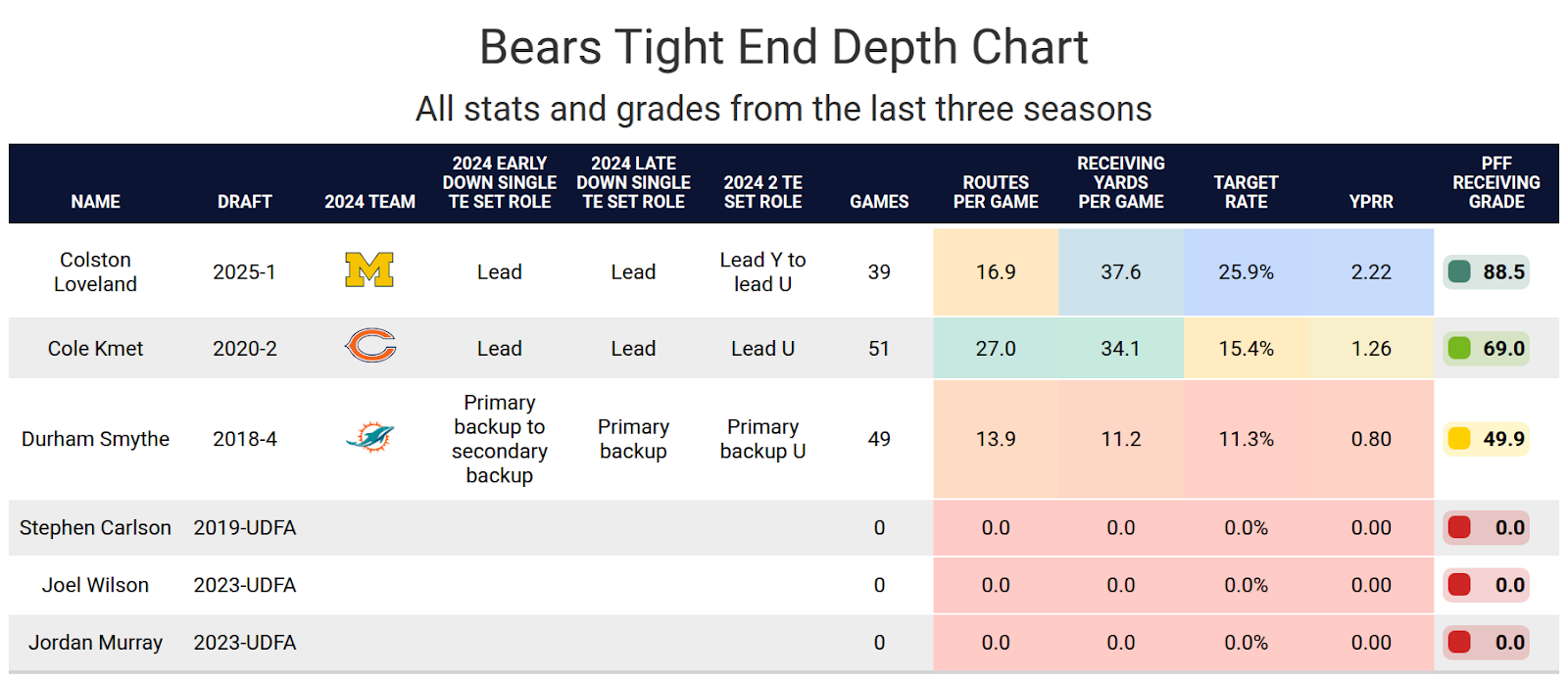
Impact of teammates
Ben Johnson is the new Chicago Bears head coach, and a big reason to be optimistic about Loveland. In Detroit, he had Sam LaPorta, who has a 53.2 run-blocking grade over the last two seasons. That didn’t stop Johnson from playing LaPorta consistently in 11 and 12 personnel, only taking him off the field consistently in 21 personnel. This is likely the path Johnson will also take with Loveland. Chicago doesn’t have a true fullback on the roster, but there will likely be some clear run situations where Kmet and Durham Smythe are on the field instead of Loveland, but this hasn’t been a problem for players like LaPorta or T.J. Hockenson.
Johnson also typically runs a lot of plays and has a high points-per-game total. All optimism on the offense hinges on Caleb Williams’ development. Williams had three games this season with an offensive grade above 80.0 but ended the season with a passing grade below 60.0 in five of his final six games. The former first overall pick has an entirely re-worked offensive line and multiple new receivers to throw to, so he’s being given every opportunity to succeed. Williams’ willingness to throw deep targets more than most quarterbacks could lead to some big plays by Loveland. LaPorta led all tight ends in deep receiving yards last season, so Johnson knows how to draw up deep shots to the tight end position.
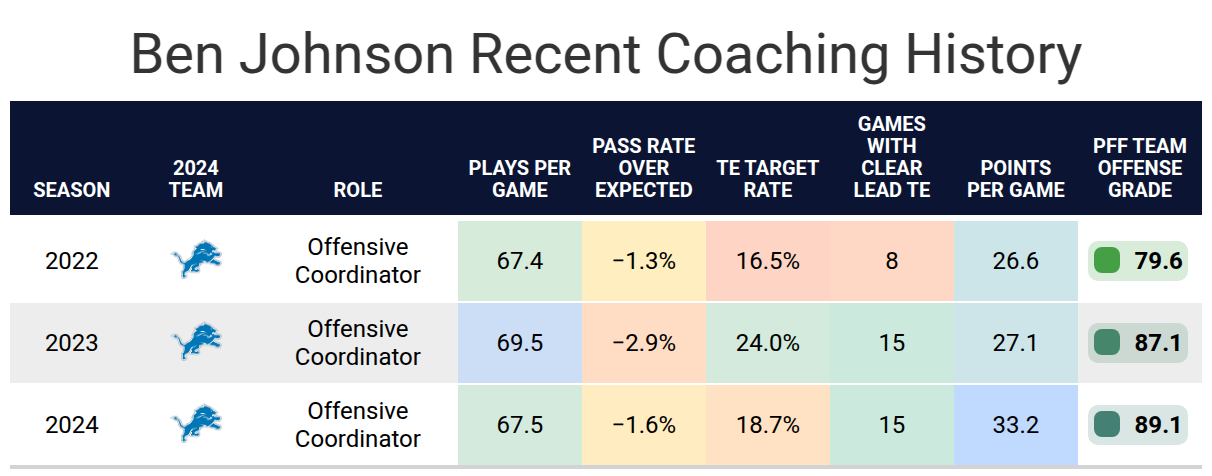
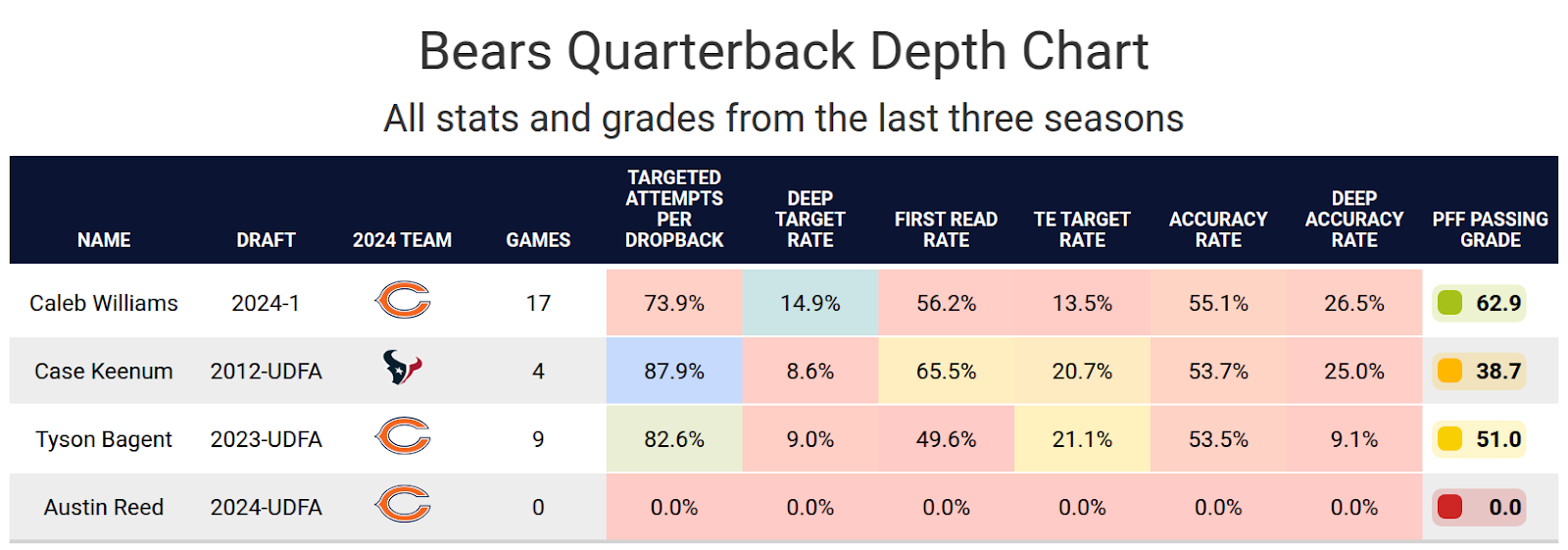
Bottom line
Loveland has all of the makings of the next elite fantasy tight end. Ben Johnson’s offense needs to work out, and Caleb Williams needs to take a step forward for Loveland to get there. Still, it’s reasonable to be optimistic about Loveland’s production as a rookie.
Footnotes
- Statistics in tables and charts were chosen based on their ability to predict future fantasy performance on a per-game or per-opportunity basis or to describe the player relative to others at the same position.
- “Opportunities” are defined as passing dropbacks, rushing attempts and routes run as a receiver.
- Numbers are provided either by season or based on the past three years. For rookies, only college statistics are included. For non-rookies, only NFL statistics are considered, regardless of whether they played in college within the previous three years.
- As college competition is easier than NFL competition, most rookies are likely to see a decline from their historical numbers.
- Only FBS data is considered for college players and comparisons.
- Kneel-downs are removed from rushing data to provide cleaner quarterback rushing rate statistics.
- The table colors in this article range from blue (indicating good/high) to red (indicating bad/low).
- All percentiles and color codings compare the given player to others with a high sample of opportunities. Generally, the cutoff is one-third of the possible opportunities in the sample. If a player does not meet the threshold, they are still included in the comparison, though their results may appear better or worse than expected due to the smaller, less predictive sample size.
- Information on utilization classifications and their importance can be found here for running backs, wide receivers and tight ends.
This news was originally published on this post .










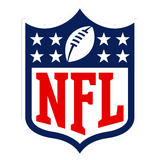
Be the first to leave a comment